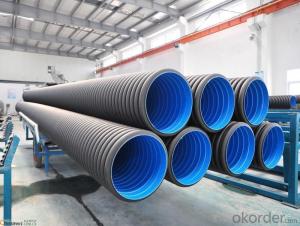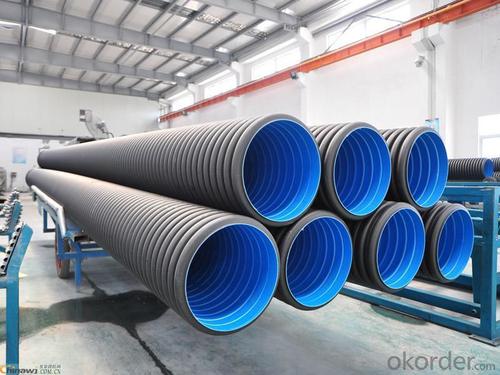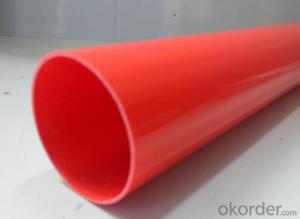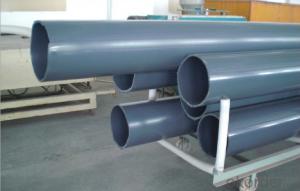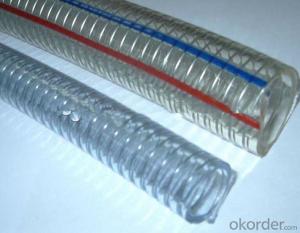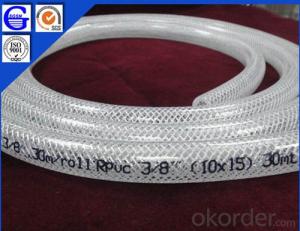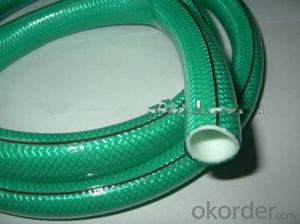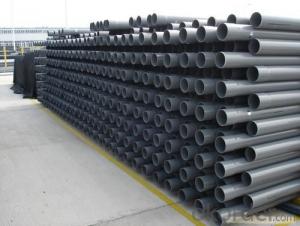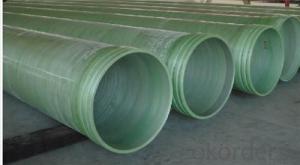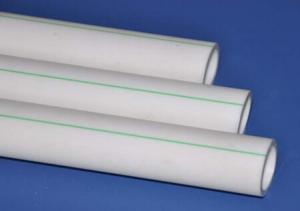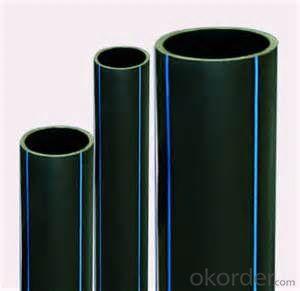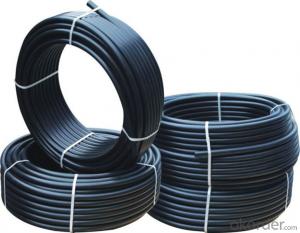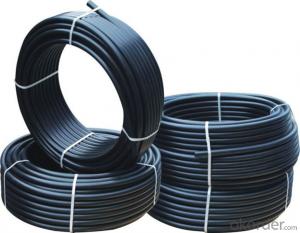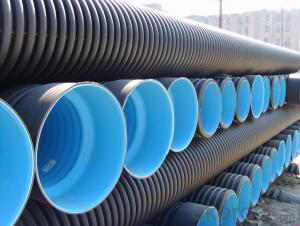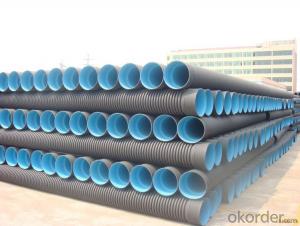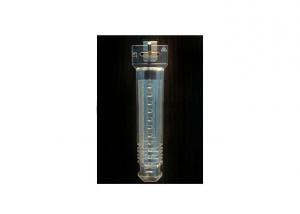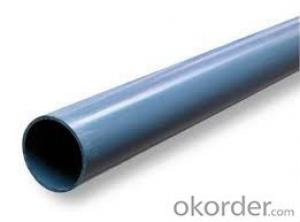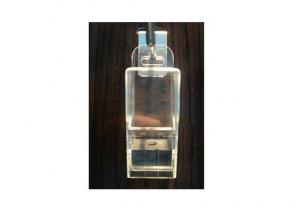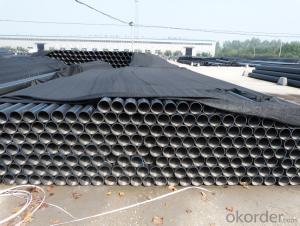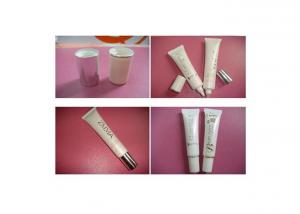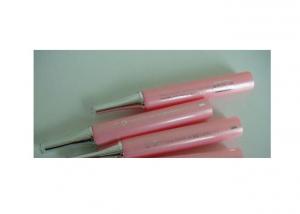Plastic Tubes HDPE Pipe PE100 PE80 CNBM Manufacturer ISO4277
- Loading Port:
- Tianjin
- Payment Terms:
- TT OR LC
- Min Order Qty:
- 100 m
- Supply Capability:
- 3000 m/month
OKorder Service Pledge
OKorder Financial Service
You Might Also Like
Specifications
1.Material: HDPE100
2.Color: Black or white with blue stripe
3.PN Grade:0.6-1.6MPa
4.Certification:ISO9001 CE
Feature:
1.Material:pe100
2.Standard:GB/T13663-2000
3.Certification:ISO9001:2008
4.Package:plastic filmed
5.Color:black with blue stripe or on request
6.SDR rating:SDR11 SDR13.6 SDR17 SDR21 SDR26
Applications:
1.Municipal water supply, gas supply and agriculture etc.
2.Commercial & Residential water supply
3.Industrial liquids transportation
4.Sewage treatment
5. Food and chemical industry
7. Replacement of cement pipes and steel pipes
8. Argillaceous silt, mud transportation
9. Garden green pipe networks
Advantage:
1.Non-toxic
2.Light Weight
3.No Leakage.
4.High Ductility.
5.Hygienic Safety
6.Toughness
7.Smooth Surface
8.Corrosion resistant.
9.Excellent Flexibility
10.Chemically Inert
11.Resistance to Abrasion
12.Good resistance ability for scratch.
13.Recycle and environment-friendly
14.Many new construction method,such as butt fusion and socket joint.
15.Easy Installation and Lower costs
16.Ageing resistance and long service life,50 years under pressure use
Properties :
1.Specific Gravity, g/cm3, 20(C): 0.941-0.965
2.Longitudinal Reversion, % (110(C)): <=3< span="">
3.Oxidation Induciton Time, min (200(C)): >=20
4.Extension Rate at Break. %: >=350
5.Hydraulic Pressure Test:
1)20(C), Hoop Stress is 12.4 Mpa, 100h: No Failure.
2)80(C), Hoop Stress is 5.5Mpa, 165h: No Failure.
3)80(C), Hoop Stress is 5.0Mpa, 1000h: No Failure.
- Q: the tank is four sided and some what triangular and the top is attached to tank
- Well, you could get some PVC tubing and cut it to size, but that would probably cost as much as just getting a new filter. You could get a new UG filter (undergravel) but frankly, UG filters are not very effective. In theory, they suck all the gunk, poop, uneaten food into the gravel where it can biodegrade. It's a good idea, but in reality, the gunk just rots. It's like if you threw food, and pooped in your backyard. If you only did that a teeny bit, it might biodegrade, but if you did that alot, it would just pile up and rot. That's basically what happens. In a 5 gallon tank, waste adds up very quickly, even with just one fish. I suggest you get a hang off the back (waterfall) filter. They are much more effective. You'll still need replace 20% of the water every week, but it'll keep your tank crystal clear.
- Q: How do you transport plastic tubes?
- Plastic tubes can be easily transported by packaging them securely in boxes or crates, using appropriate cushioning materials to prevent damage during transit.
- Q: Hi all. My mom gave me an old lamp, not old cool or worth something just old. I think the proper term would be free standing. It has four bulbs, three surround the center bulb under a lamp shade. I'm trying to update the thing a little... painted the base and stand, got a new lamp shade, put in energey efficent bulbs.. the only part that is bugging me are these three plastic peices whose purpose is to cover the wires running to the bulbs above. One of them is cracked so i want to replace all three. Hoping someone can tell me the name of what I need before I gassed it to the closest home depot/lowes to return empty handed.Thanks for you help.
- Take the piece with you to the closest of these 2 stores and look in the plumbing isle for PVC pipe the same size. If the new pipe has writing on it you need to get off use a scotch brite pad.
- Q: do i need to need to clean the gas tube on my ar-15?
- Not really! However, I do know some AR15 users who will put, something like 10 or 12 thousand rounds through an AR; and, then, they'll remove the gas tube (or gas tube and front sight assembly) and let it soak in a tray of powder solvent for a day, or two, before finally draining it and blowing it out with a can of compressed air from either a computer or auto parts store. (Only the lucky ones have compressors!) In the alternative you can — again only on rare occasions — use a can of non-chlorinated carburetor or brake cleaner in order to do the same thing. Just stick the long plastic tube that comes with one of these cans inside the gas tube and blast away! All this being said: It's only rarely necessary to clean an AR gas tube because, in a way, every time you fire an AR the gas tube, pretty much, cleans itself — OK!
- Q: Can plastic tubes be used for fluid transfer in laboratory settings?
- Yes, plastic tubes can be used for fluid transfer in laboratory settings. They are commonly used due to their flexibility, durability, and compatibility with a wide range of chemicals. However, it is important to select the appropriate type of plastic tubing that is chemically resistant and suitable for the specific application to ensure accurate and reliable results.
- Q: Are plastic tubes suitable for structural applications?
- No, plastic tubes are generally not suitable for structural applications as they lack the necessary strength and durability compared to materials like steel or concrete.
- Q: Are plastic tubes suitable for hydraulic applications?
- No, plastic tubes are not suitable for hydraulic applications due to their limited strength and inability to withstand high pressure and temperature conditions.
- Q: Also if this isn't safe then how unsafe was it when some kid spilled a whole container of mercury on the floor in my class and started playing with it. Ya anyway i would never touch it.
- Your Hg is safe in the tube and MUCH safer than some kid plating with it with his fingers. The expression Mad as a Hatter comes from olden days when the felt on hats was applied with a mercury paste by workers using their hands
- Q: What are the advantages of using plastic tubes in the industrial packaging industry?
- There are several advantages of using plastic tubes in the industrial packaging industry. Firstly, plastic tubes are lightweight, which makes them easy to handle and transport. This reduces shipping costs and allows for more efficient logistics. Secondly, plastic tubes provide excellent protection to the packaged goods. They are resistant to moisture, chemicals, and impact, ensuring that the contents remain intact and undamaged during transportation and storage. Additionally, plastic tubes are customizable in terms of size, shape, and color, offering flexibility to cater to different product requirements. This allows for efficient and attractive packaging solutions that can enhance product visibility and brand image. Moreover, plastic tubes are recyclable, contributing to sustainable packaging practices and reducing environmental impact. They can be reused or repurposed, promoting a circular economy and reducing waste. Overall, the advantages of using plastic tubes in the industrial packaging industry include cost-effectiveness, product protection, customization options, and sustainability.
- Q: What's the little piece of plastic called?
- wall anchor -- they also have metal ones for mason or brick walls ..... If you are hanging things from the walls, look into those new wall hooks from 3M that paste to the wall and you can peel it off so that you do not damage the wall.
Send your message to us
Plastic Tubes HDPE Pipe PE100 PE80 CNBM Manufacturer ISO4277
- Loading Port:
- Tianjin
- Payment Terms:
- TT OR LC
- Min Order Qty:
- 100 m
- Supply Capability:
- 3000 m/month
OKorder Service Pledge
OKorder Financial Service
Similar products
Hot products
Hot Searches
Related keywords
